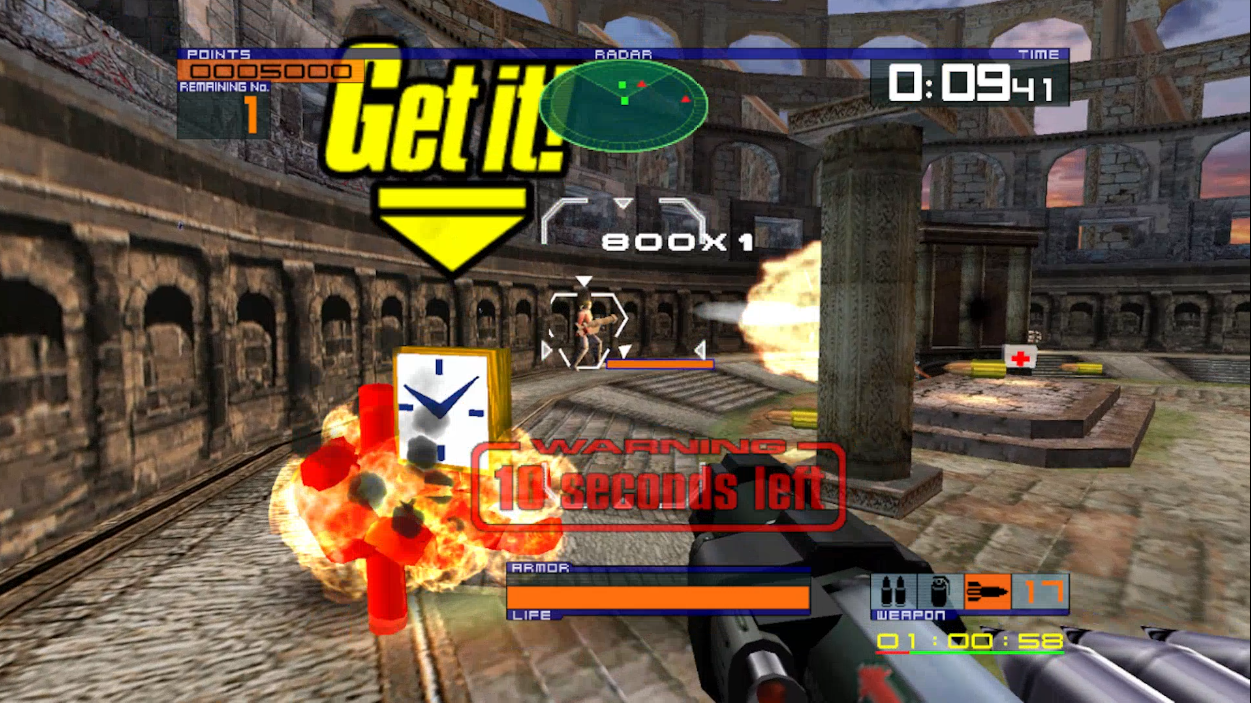

Yeah, you heard that right.
If you are familiar with what arena shooters are, then you are likely aware of how there aren't any new games like those anymore ever since they were basically buried by shooters like Call of Duty in the early 2010s and then battle royale + hero shooter games in the late 2010s to 2020s.
And to add to that case, if the term arena shooter doesn't ring a bell, then maybe the names Quake and Unreal Tournament will do. Those two were the most known arena shooter games and thrived in their prime through their focus on multiplayer battles.
With that little context, it may be surprising for you to hear that SEGA, which you would likely know for either their active franchises [Sonic, Like a Dragon, Virtua Fighter, Super Monkey Ball] or from their less maintained but still beloved IPs from their arcade prime back in the 90s [Daytona USA, Outrun, Streets of Rage]...and the idea of them making a FPS doesn't really sound likely from them if you think about it.
Which is why it was curious to be reminded of today's game once again, as Outtrigger wasn't just a FPS game published by SEGA, but was made by their AM2 division and released straight to arcades - with a Dreamcast port not too long after.
So that's going to be what I'll talk about, first going about how it was setup in the arcade [both the mode and the orginal cabinet] plus mentioning a few other games like it, and then going a bit more into the details of the gameplay and the added features on the Dreamcast version.
Joystick and a trackball for aiming on a cabinet?
Well, unless you are Typing of the Dead, you wouldn't expect an arcade cabinet to just cram a keyboard and a mouse in there for playing a shooter game - closest thing being the Left 4 Dead Survivors arcade conversion that has a Wii Nunchuck-like controller for your left hand...and a mouse on the right hand for you to use on top of the arcade panel.
But Outrigger, probably because it was made years before that attempt, uses a joystick for the left hand...and a trackball for the right hand. I will assume that its a bit weird to see at first, but could have worked well considering that you'd have some precision on aiming through moving the trackball rather than just using another joystick to awkwardly aim without aim assist.
With that said, now I can go and talk about what the game itself has in offer - at least in its Dreamcast conversion.
Take them down quick if you want to win
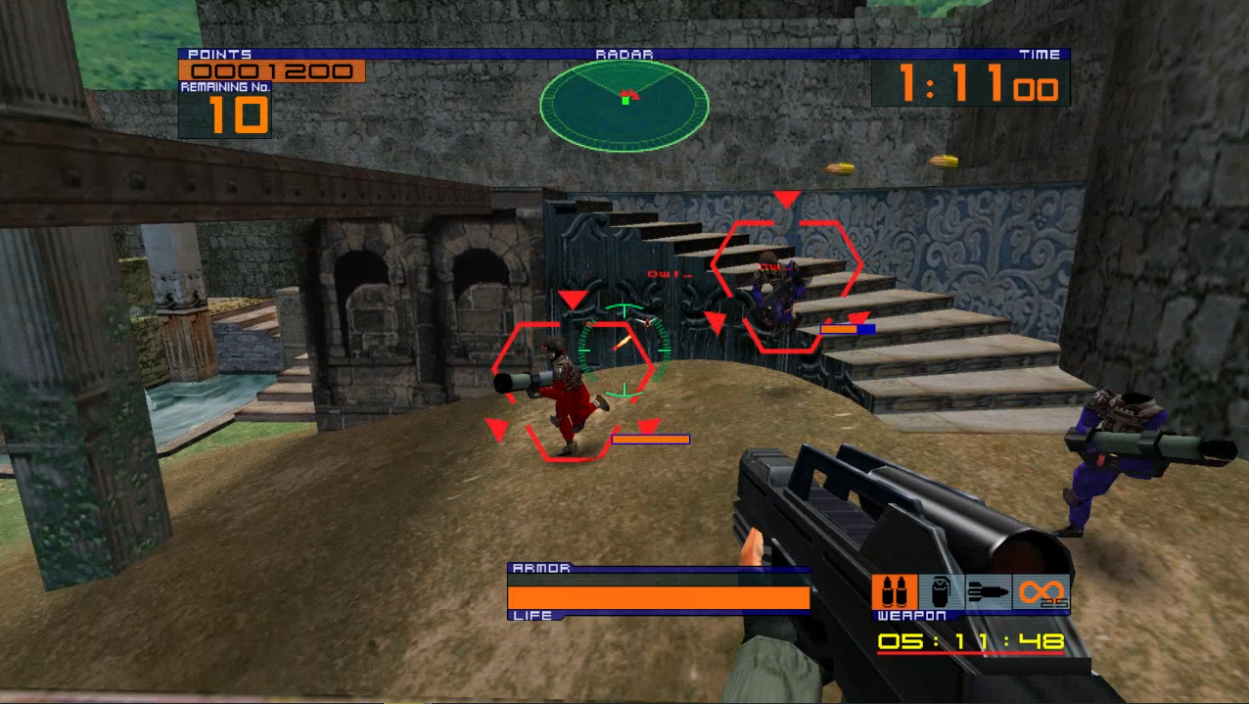
Outtrigger's default arcade mode has you choose between four courses - the first one makes sense that is pretty easy between picking up items to test movement, shooting down static enemies, and then eventually a small arena fight against other CPUs.
But the other ones will take you more than basics to get through without continues, as they all consist in matches against CPU players and having to defeat a set number of them before time runs out - this being an arcade game after all.
You can get time extensions from some enemies, but since you're always on a timer, you'll want to make sure you get them immediately whenever you blow up someone - as those enemies can also pick up the time items instead.
There's also a few times in these arcade courses where you're on a team mission, having a partner that can help you by attacking enemies [and their kills also count as yours]...but can also make you lose time should you accidentally kill them.
Your weapons for doing so are a missile launcher, grenades and a machine gun. The Missile Launcher and Grenades have limited ammo, but have enough to start going for players from the get go and can be refilled with ammo items [look like bullets] or after respawning.
There's also a Mission mode added in the Dreamcast port that, while has most of the starting missions be a glorified tutorial, does add a bit more creative stuff later, like this mission where you have to use the Machine Gun on top of a pillar [you're glued there] to defend a civilian in the middle of the coliseum from enemies that spawn and try to attack him.
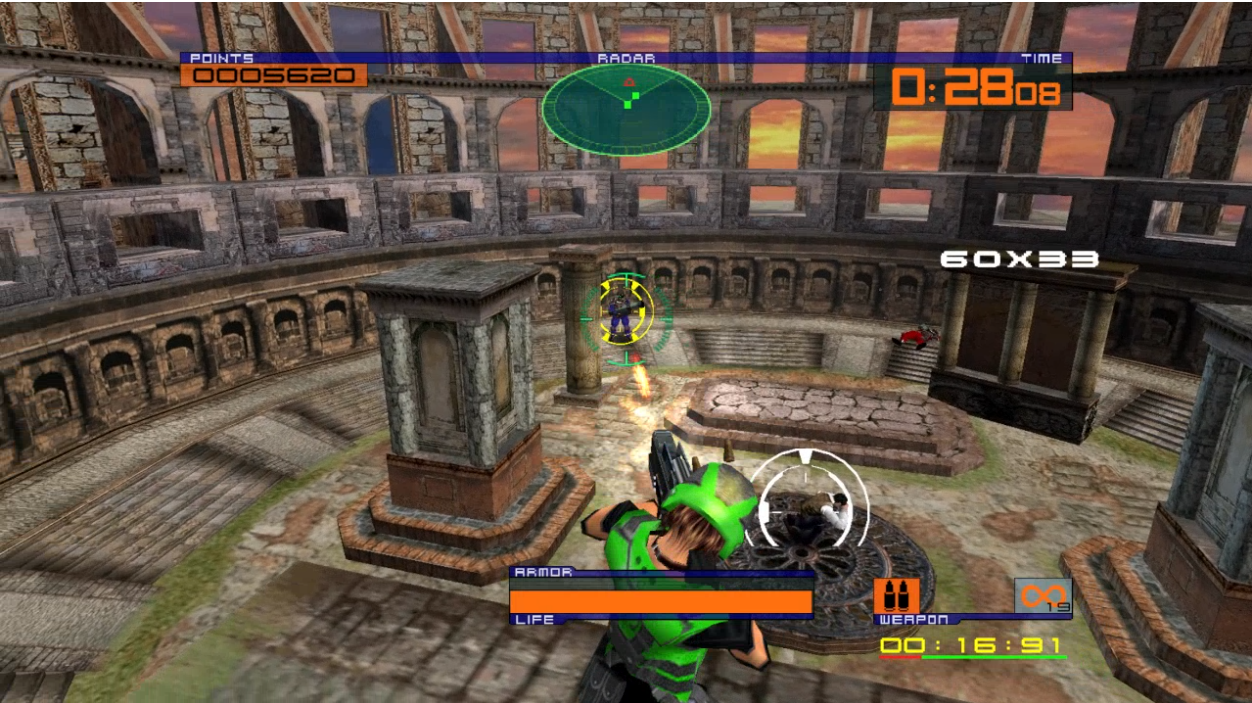
You could play with Keyboard and Mouse on a Dreamcast game?
If you somehow had both peripherals available, yes, you could indeed plug both of them and play as if it were a PC FPS game...although the key binds can be weird [you move with the Arrow Keys - or ESDF if you change the profile to B in the control settings] and cannot be remapped if you do.
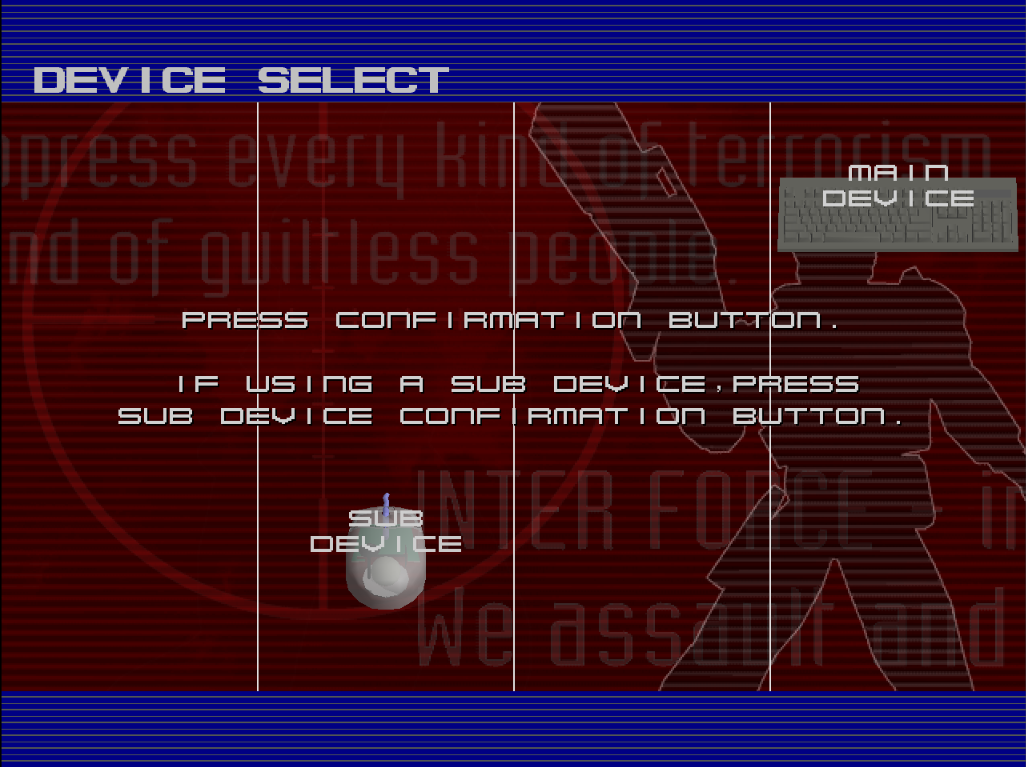
But whether you somehow have these two peripherals to hook them up into a Dreamcast [or are using emulation and configuring this to work], its kind of surreal that this already weird SEGA arena shooter game on a Dreamcast console can actually be played as if you were playing any other FPS on a PC. Which is slightly ironic when you think that this was never ported to PCs unlike some other Dreamcast arcade games of the era...or any other platform for that matter.
Although you can also use the Mouse paired with the Controller if you wanted to do that [or want to remap the movement buttons by mapping the controller to a keyboard], which I'd recommend for playing on a KB+M setup in PC to bypass the non-remappable inputs.
IIRC Quake 3 Arena also had support for these peripherals. But its still pretty interesting that SEGA's take on a shooter had enough care to implement support for them here. Although now that I mention Quake 3...
Enclosed in the shadow of bigger arena shooters?
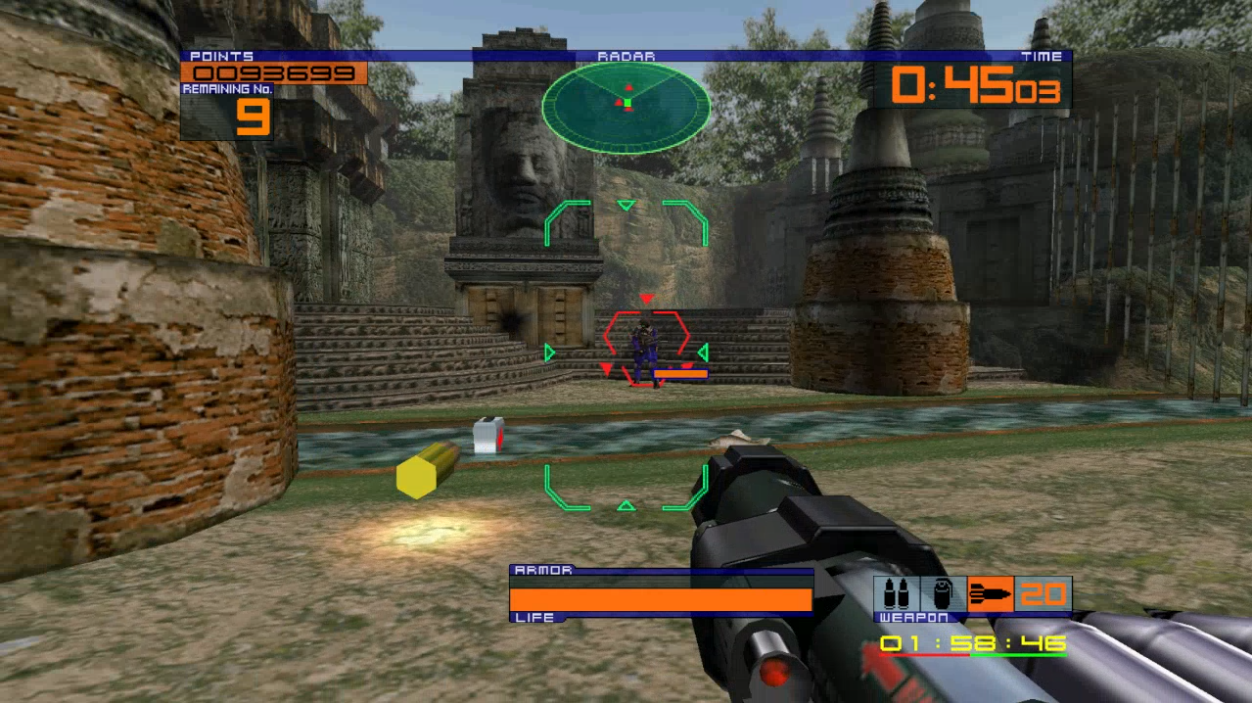
The game is interesting for what its made for at the time, an arena shooter game that was first designed for the arcade [rather than a conversion of a PC shooter to arcade] and then received a Dreamcast port with support for those Keyboard and Mouse peripherals on top of support for online matches.
...But my guess on why it has been forgotten to time for the most part, wouldn't just be because of the unfortunate downfall in popularity of arena shooters themselves, but also how this game's quirks end up making it an oddball even around other arena shooters of the era.
Namely, Quake 3 Arena and Unreal Tournament were both available on the Dreamcast with the same KB+M and online match support, which means that if you had a Dreamcast but recognized those two names, you would likely go for those games over the less-recognizable Outtrigger.
Talking about the game qualities themselves though, maybe this was designed for the low player count the game has [up to 6 in online, 4 in local] or just because it was designed as an arcade game first, most if not all maps in Outtrigger are pretty small in scale, a couple having some verticality and places to hide at, but overall are not anywhere near the scale of most Q3 and UT maps.
Besides the occasional health and ammo pickups, at least you can still find stuff like the Power Up item [temporary damage increase], armor to take more damage, thermography goggles to see players from behind walls [although if playing in teams, you can't tell between friend or enemy unless you see them directly] and even a few special weapons like the effective up-close Flamethrower and the bouncing Photon Torpedo.
Conclusion
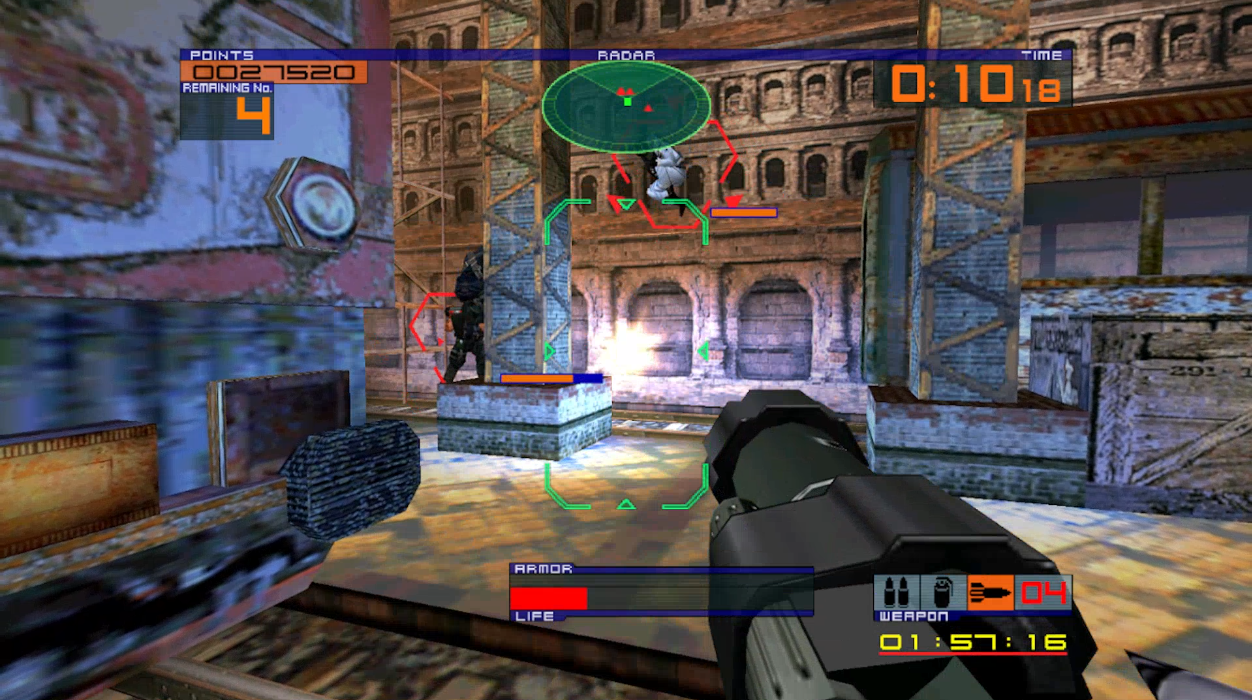
Outtrigger is certainly a bit of a weird game, both in its origins and intended platform, as well as how its set to be played compared to other arena shooters.
The arcade mode is okay for choosing a set of challenges to go through in one go, letting yourself aim for a no continue run if you think you can clear all the stages in time, and the missions aren't that many but add a bit more to do outside of the arcade mode. But beyond those two things, there isn't much in offer on a single player experience.
Trying this game out nowadays could still be a breath of fresh air between the more arcadey gameplay and even the more enclosed maps meaning you should run more frequently into enemy players to blast away - although you may also miss out on running over big maps and blowing up many CPU players as you get better weapons.
At the very least though this game does use its enclosed areas to have you move at breakneck pace hunting for other enemies in order to keep the timer up in the Arcade mode, and even outside of that, the small map sizes mean you're always likely to run into someone.
And in any case, its super interesting to be able to play an arena shooter straight from the hands of SEGA AM2, with how they have been known for many types of arcade games - but this one is such a cool odd one out from them because of the genre it tackled.
https://youtu.be/4_uieKphP6M
Thanks for reading, and see you next time.

Spanish translation with DeepL. All screenshots were captured by myself.
Español

Si estás familiarizado con los shooters de arena, probablemente sepas que ya no hay juegos nuevos de este tipo desde que quedaron prácticamente sepultados por shooters como Call of Duty a principios de la década de 2010 y, posteriormente, por los juegos battle royale + hero shooter a finales de la década de 2010 y principios de la de 2020.
Y, por si fuera poco, si el término «juego de disparos en arena» no te suena, quizá te suenen los nombres Quake y Unreal Tournament. Estos dos fueron los juegos de disparos en arena más conocidos y prosperaron en su apogeo gracias a su enfoque en las batallas multijugador.
Con ese pequeño contexto, puede que te sorprenda saber que SEGA, a la que probablemente conozcas por sus franquicias activas [Sonic, Like a Dragon, Virtua Fighter, Super Monkey Ball] o por sus IP menos mantenidas, pero aún queridas, de su apogeo en las salas recreativas en los años 90 [Daytona USA, Outrun, Streets of Rage]... y la idea de que ellos crearan un FPS no parece muy probable si lo piensas bien.
Por eso me ha resultado curioso recordar el juego de hoy, ya que Outtrigger no era solo un juego FPS publicado por SEGA, sino que fue creado por su división AM2 y lanzado directamente a las salas recreativas, con una versión para Dreamcast poco después.
Así que eso es de lo que voy a hablar, primero sobre cómo estaba configurado en la sala recreativa [tanto el modo como la máquina original], además de mencionar algunos otros juegos similares, y luego profundizar un poco más en los detalles de la jugabilidad y las características añadidas en la versión para Dreamcast.
¿Un joystick y un trackball para apuntar en una máquina recreativa?
Bueno, a menos que seas Typing of the Dead, no esperarías que una máquina recreativa tuviera un teclado y un ratón para jugar a un juego de disparos. Lo más parecido es la conversión arcade de Left 4 Dead Survivors, que tiene un mando similar al Nunchuck de la Wii para la mano izquierda... y un ratón en la mano derecha para usar sobre el panel arcade.
Pero Outrigger, probablemente porque se creó años antes de ese intento, utiliza un joystick para la mano izquierda... y un trackball para la mano derecha. Supongo que al principio resulta un poco extraño, pero podría haber funcionado bien teniendo en cuenta que se consigue cierta precisión al apuntar moviendo el trackball en lugar de utilizar otro joystick para apuntar torpemente sin ayuda.
Dicho esto, ahora puedo pasar a hablar de lo que ofrece el juego en sí, al menos en su conversión para Dreamcast.
Acaba con ellos rápidamente si quieres ganar

El modo arcade predeterminado de Outtrigger te permite elegir entre cuatro niveles: el primero es bastante fácil, ya que consiste en recoger objetos para probar los movimientos, derribar enemigos estáticos y, finalmente, luchar en una pequeña arena contra otras CPU.
Pero los demás te exigirán más que lo básico para superarlos sin continuar, ya que todos consisten en combates contra jugadores controlados por la CPU y en tener que derrotar a un número determinado de ellos antes de que se acabe el tiempo, ya que, al fin y al cabo, se trata de un juego arcade.
Puedes conseguir extensiones de tiempo de algunos enemigos, pero como siempre estás contra reloj, querrás asegurarte de conseguirlas inmediatamente cada vez que derribes a alguien, ya que esos enemigos también pueden recoger los objetos de tiempo.
También hay algunas ocasiones en estos cursos arcade en las que estás en una misión en equipo, con un compañero que puede ayudarte atacando a los enemigos (y sus muertes también cuentan como tuyas)... pero que también puede hacerte perder tiempo si lo matas accidentalmente.
Tus armas para ello son un lanzamisiles, granadas y una ametralladora. El lanzamisiles y las granadas tienen munición limitada, pero suficiente para empezar a disparar a los jugadores desde el principio y se pueden rellenar con objetos de munición (parecidos a balas) o después de reaparecer.
También hay un modo Misión añadido en la versión para Dreamcast que, aunque la mayoría de las misiones iniciales son un tutorial glorificado, añade cosas un poco más creativas más adelante, como esta misión en la que tienes que usar la ametralladora en lo alto de un pilar [estás pegado allí] para defender a un civil en medio del coliseo de los enemigos que aparecen y tratan de atacarlo.

¿Se puede jugar con teclado y ratón en un juego de Dreamcast?
Si de alguna manera dispones de ambos periféricos, sí, puedes conectarlos y jugar como si fuera un juego FPS de PC... aunque las teclas asignadas pueden resultar extrañas [te mueves con las teclas de flecha, o con ESDF si cambias el perfil a B en la configuración de control] y no se pueden reasignar si lo haces.

Pero tanto si de alguna manera tienes estos dos periféricos para conectarlos a una Dreamcast [o estás utilizando emulación y configurándola para que funcione], resulta un poco surrealista que este juego de disparos de SEGA, ya de por sí extraño, pueda jugarse en una consola Dreamcast como si se tratara de cualquier otro FPS en un PC. Lo cual resulta un poco irónico si pensamos que nunca se adaptó a PC, a diferencia de otros juegos arcade de Dreamcast de la época... o a cualquier otra plataforma, para el caso.
Aunque también puedes usar el ratón junto con el mando si lo deseas [o quieres reasignar los botones de movimiento asignando el mando a un teclado], lo cual recomendaría para jugar en una configuración de teclado y ratón en PC para evitar las entradas no reasignables.
Si no recuerdo mal, Quake 3 Arena también era compatible con estos periféricos. Pero sigue siendo bastante interesante que SEGA se preocupara lo suficiente como para implementar la compatibilidad con ellos en su shooter. Aunque ahora que menciono Quake 3...
¿A la sombra de shooters de arena más grandes?

El juego es interesante por lo que se creó en su momento, un shooter de arena que se diseñó primero para recreativas [en lugar de ser una conversión de un shooter de PC a recreativas] y luego recibió una versión para Dreamcast con soporte para teclado y ratón, además de soporte para partidas online.
... Pero mi hipótesis sobre por qué ha caído en el olvido en su mayor parte no se debe solo a la desafortunada caída en popularidad de los juegos de disparos en arena en sí, sino también a que las peculiaridades de este juego lo convierten en un bicho raro incluso entre otros juegos de disparos en arena de la época.
Concretamente, Quake 3 Arena y Unreal Tournament estaban disponibles en Dreamcast con la misma compatibilidad con teclado y ratón y partidas online, lo que significa que si tenías una Dreamcast y conocías esos dos nombres, probablemente te decantarías por esos juegos en lugar del menos conocido Outtrigger.
Sin embargo, hablando de las cualidades del juego en sí, tal vez este fue diseñado para el bajo número de jugadores que tiene [hasta 6 en línea, 4 en local] o simplemente porque fue diseñado primero como un juego de arcade, la mayoría, si no todos, los mapas de Outtrigger son bastante pequeños, algunos tienen cierta verticalidad y lugares donde esconderse, pero en general no se acercan a la escala de la mayoría de los mapas de Q3 y UT.
Además de las ocasionales recogidas de salud y munición, al menos todavía se pueden encontrar cosas como el objeto Power Up [aumento temporal del daño], armadura para recibir más daño, gafas termográficas para ver a los jugadores detrás de las paredes [aunque si se juega en equipos, no se puede distinguir entre amigos y enemigos a menos que se les vea directamente] e incluso algunas armas especiales como el eficaz lanzallamas de corto alcance y el rebotante torpedo de fotones.
Conclusión

Outtrigger es sin duda un juego un poco extraño, tanto por sus orígenes y la plataforma para la que está pensado, como por su forma de jugar en comparación con otros shooters de arena.
El modo arcade está bien para elegir un conjunto de desafíos que superar de una sola vez, permitiéndote intentar una partida sin continuaciones si crees que puedes superar todas las fases a tiempo, y las misiones no son muchas, pero añaden un poco más que hacer fuera del modo arcade. Pero, aparte de esas dos cosas, no hay mucho más que ofrecer en la experiencia para un solo jugador.
Probar este juego hoy en día podría seguir siendo un soplo de aire fresco entre la jugabilidad más arcade y los mapas más cerrados, lo que significa que deberías encontrarte con más frecuencia con jugadores enemigos a los que disparar, aunque también te perderías la posibilidad de recorrer grandes mapas y volar por los aires a muchos jugadores controlados por la CPU a medida que consigues mejores armas.
Sin embargo, al menos este juego utiliza sus áreas cerradas para que te muevas a un ritmo vertiginoso en busca de otros enemigos con el fin de mantener el temporizador en el modo Arcade, e incluso fuera de eso, el pequeño tamaño de los mapas significa que siempre es probable que te encuentres con alguien.
En cualquier caso, es muy interesante poder jugar a un shooter de arena directamente de la mano de SEGA AM2, conocida por muchos tipos de juegos arcade, pero este es uno de los más curiosos de todos ellos debido al género que aborda.
https://youtu.be/4_uieKph